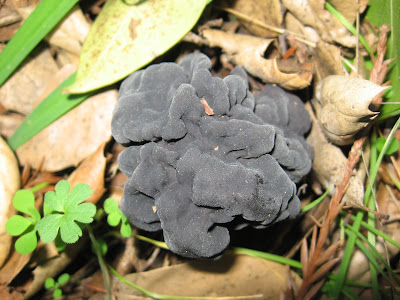
I was raking leaves in the front yard when I noticed this mysterious object amongst the leaf litter. My first thought, seeing it from a distance, was that the dog had chewed up one of my black socks and left it lying there (he does have a fondness for our well worn socks).

When I came closer it revealed itself as a strange growth, ominously alive.
Nothing stays mysterious for long in the internet age. I typed into Google Search the description of what it looked like to me: "wrinkled black fungus" -- and soon found a reasonably close photo and identification. The photo, taken on a trail side in Poland, is posted on TrekNature, a place for adventurous travelers to share their finds.
Adrian Szatewicz kindly provides the name and features, and Wikipedia fills out the story. This is an evil cousin of the marvelous and much-sought-after morel mushroom, called Gyromitra esculenta, or "brain mushroom." "Esculenta" means it can be eaten and supposedly, it can, if cooked properly, with all windows open to vent the poisonous fumes which have the same chemical composition as rocket fuel. In some parts of Europe it is sold in markets. But don't try this at home, kids! It can also cause illness and death.
I have never wanted to touch wild mushrooms since the time I read a newspaper article about the head of the local mycological society, who succumbed to an ill-chosen fungus. Even the experts can make mistakes.
The most interesting thing I learned is that some mushrooms, like this one, are mostly saprotrophic: they live on decaying organic matter. Others are mostly mychorrhizal: they send out thin white filaments which interpenetrate the rootlets of plants in a symbiotic exchange of nutrients, an important factor in soil chemistry. Having lots of mychorrhizal activity in your soil is a good thing for your plants.
No comments:
Post a Comment